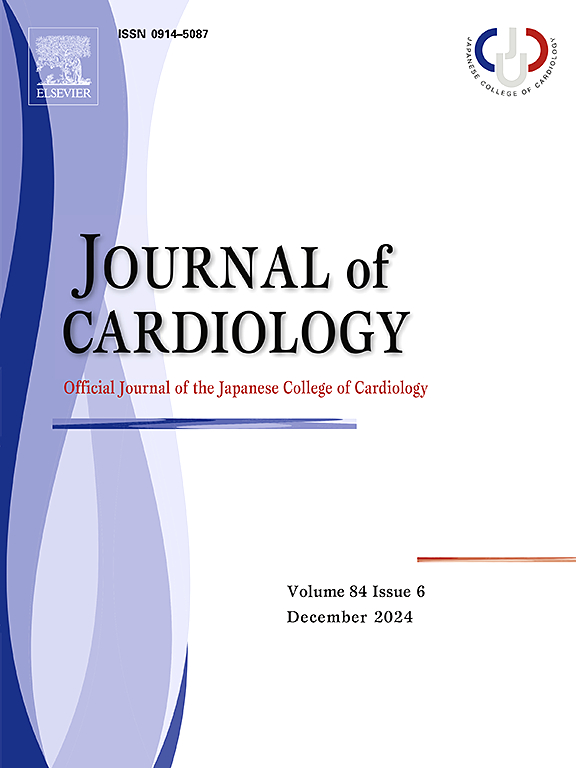Usefulness of intraoperative color three-dimensional transesophageal echocardiography for detecting treatable residual mitral regurgitation immediately after mitral valve repair
IF 2.5
3区 医学
Q2 CARDIAC & CARDIOVASCULAR SYSTEMS
引用次数: 0
Abstract
Background
Residual mitral regurgitation (MR) immediately after mitral valve (MV) repair is a risk factor for late reintervention. This study aimed to determine the feasibility of color 3-dimensional intraoperative transesophageal echocardiography (3D-IOTEE) for clarifying the mechanism of residual MR and its impact on the conversion rate to MV replacement (MVR).
Methods
Among 767 patients who underwent MV repair at our institute, 92 consecutive patients in whom an immediate second cardiopulmonary bypass (CPB) was performed due to MV repair for residual MR were evaluated. The patients were divided into the re-repair group [i.e. those in whom repair required additional procedures, n = 77 (83.7 %)] and the MVR group [i.e. patients who underwent MVR alone, n = 15 (16.3 %)]. All patients underwent 3D-IOTEE to evaluate the mechanisms of residual MR. The pathomechanisms were classified into the following five categories: Category 1, inter-scallop malcoaptation; Category 2, suture dehiscence; Category 3, prolapse; Category 4, systolic anterior motion of the MV; and Category 5, tethering. Clinical background and outcomes were compared between the two groups based on the five categories.
Results
The rate of MVR conversion by etiology of residual MR after the first MV repair was 68.8 % (n = 11/16) in Category 1; 0 % (n = 0/22) in Category 2; 2.4 % (n = 1/41) in Category 3; 20 % (n = 2/10) in Category 4; and 33.3 % (n = 1/3) in Category 5. Among the 63 patients with Category 2 and 3 etiologies, 62 patients had complete MV re-repair with additional procedures [Category 2, 100 % (n = 22/22); Category 3, 97.6 % (n = 40/41)]. Meanwhile, MVR was performed owing to difficulty in MV repair after the second CPB in 11/16 patients (68.8 %) with Category 1 etiology.
Conclusions
In the assessment of MR, 3D-IOTEE is useful for lesion localization and determining the origin and severity of MR, which are key factors in selecting the optimal surgical approach in patients undergoing re-repair.
术中彩色三维经食道超声心动图对检测二尖瓣修复术后可立即治疗的残余二尖瓣反流的实用性。
背景:二尖瓣(MV)修复术后立即残留二尖瓣反流(MR)是后期再次手术的风险因素。本研究旨在确定彩色三维术中经食道超声心动图(3D-IOTEE)的可行性,以明确残余二尖瓣反流的机制及其对二尖瓣置换术(MVR)转率的影响:在我院接受中风修补术的 767 例患者中,评估了 92 例因中风修补术残留 MR 而立即进行第二次心肺旁路(CPB)的连续患者。这些患者被分为再次修复组(即修复后需要进行其他手术的患者,n = 77(83.7%))和 MVR 组(即仅进行 MVR 的患者,n = 15(16.3%))。所有患者都接受了 3D-IOTEE 评估残余 MR 的机制。病理机制分为以下五类:第 1 类:扇叶间适应不良;第 2 类:缝合开裂;第 3 类:脱垂;第 4 类:中压收缩期前移;第 5 类:系带。根据五个类别对两组的临床背景和结果进行了比较:结果:根据第一次中风修复后残留 MR 的病因分类,第 1 类中风修复转换率为 68.8%(n = 11/16);第 2 类为 0%(n = 0/22);第 3 类为 2.4%(n = 1/41);第 4 类为 20%(n = 2/10);第 5 类为 33.3%(n = 1/3)。在 63 名病因为第 2 类和第 3 类的患者中,62 名患者通过附加手术完成了中压再修复[第 2 类,100%(n = 22/22);第 3 类,97.6%(n = 40/41)]。同时,11/16 例(68.8%)病因为 1 类的患者在第二次 CPB 后因中压修复困难而进行了中压再修:结论:在评估 MR 时,3D-IOTEE 可用于病灶定位、确定 MR 的起源和严重程度,这是为接受再修复的患者选择最佳手术方法的关键因素。
本文章由计算机程序翻译,如有差异,请以英文原文为准。
求助全文
约1分钟内获得全文
求助全文
来源期刊

Journal of cardiology
CARDIAC & CARDIOVASCULAR SYSTEMS-
CiteScore
4.90
自引率
8.00%
发文量
202
审稿时长
29 days
期刊介绍:
The official journal of the Japanese College of Cardiology is an international, English language, peer-reviewed journal publishing the latest findings in cardiovascular medicine. Journal of Cardiology (JC) aims to publish the highest-quality material covering original basic and clinical research on all aspects of cardiovascular disease. Topics covered include ischemic heart disease, cardiomyopathy, valvular heart disease, vascular disease, hypertension, arrhythmia, congenital heart disease, pharmacological and non-pharmacological treatment, new diagnostic techniques, and cardiovascular imaging. JC also publishes a selection of review articles, clinical trials, short communications, and important messages and letters to the editor.
 求助内容:
求助内容: 应助结果提醒方式:
应助结果提醒方式:


